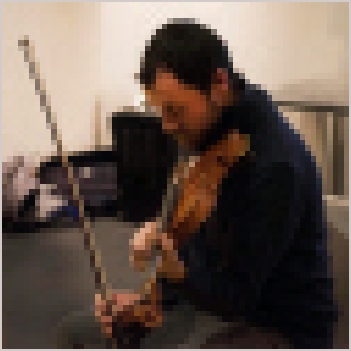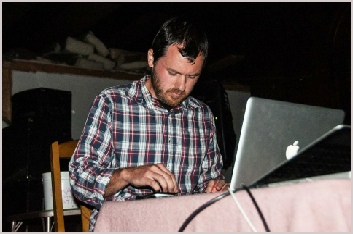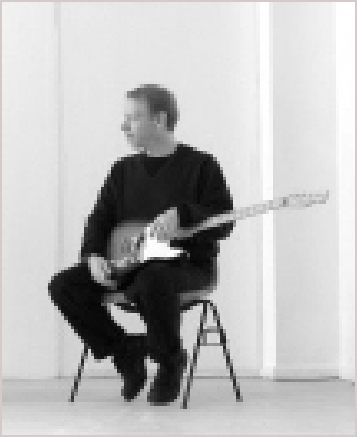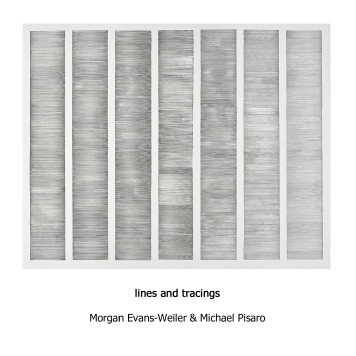Another Timbre TimHarrisonbre

at134 Morgan Evans-Weiler & Michael Pisaro ‘lines and tracings’
1. Michael Pisaro ‘Helligkeit, die Tiefe hatte, nicht keine Fläche’ (2016) 30:22 youtube extract
Ordinary Affects: Morgan Evans-Weiler, violin Luke Martin, sine tones
Michael Rosenstein, electronics Vic Rawlings, amplified / prepared cello
Katie Porter, bass clarinet JPA Falzone, vibraphone Laura Cetilia, cello
2. Morgan Evans-Weiler ‘lines and tracings’ (2018) 44:20 youtube extract
Morgan Evans-Weiler, violin Kyle Adam Blair, piano
Justin Murphy-Mancini, harpsichord Madison Greenstone, clarinet
Interview with Morgan Evans-Weiler
You previously released an improvised duo with Christoph Schiller on Another Timbre called 'spinet and violin' on Another Timbre, which is a disc that I really love. This is your first appearance on this label as a composer, and as an interpreter of other people's music (in this case Michael Pisaro's). Tell me about the balance of those three aspects of your musical life - improviser, composer, interpreter - and whether that is changing?
For me personally, it is very important that my work is encompassing all of these elements (even many more elements). Being involved with this grander community of experimental musicians and performing any of this kind of music almost necessitates a diverse approach to being a musician. It seems that everything I perform has a degree of openness that benefits greatly from those skills you gain as an improviser. And the more I have the opportunity to work on other people’s music, the better sense I have with what I want to do as an improviser. Then there are the aspects of my own compositions which come directly from improvising. It all becomes very interrelated and fluid. With that said, I do see a little mental shift happening as I have spent so much time working on performing the music of all of these wonderful people - it has been a great joy - but I’m feeling a shift as I feel I’d like to focus more on my own composition and getting some more of my pieces out into the world.
Which composers’ music have you been playing, and is it mainly through your ensemble Ordinary Affects?
Yes, most of the work I do with composers is through my group, Ordinary Affects. Ordinary Affects is a group based in the New England region - current members of the group are spread out in Boston, Providence and Middletown, CT. I started the group a few years ago as I was beginning to see the limitations of all of the improvising that I was doing. My attention was turning back to composition so it made sense to create a group that could play my open compositions as well as begin to work with the composers whose music I was most interested in. Since the group began in early 2016 we have worked with quite a few composers. We’ve commissioned new pieces from Ryoko Akama, Antoine Beuger, Michael Pisaro, Derek Baron, Teodora Stepančić, Nomi Epstein, Sarah Hughes, Jürg Frey and Jordan Dykstra as well as all the members of the group - J.P.A. Falzone, Luke Martin, Laura Cetilia and myself. This fall we have projects with Eva-Maria Houben and Christian Wolff playing new pieces written for the group. And we are working on a spring project with Magnus Granberg. All the current members of ‘Ordinary Affects’ are composer/performers, so we really prefer to work directly with other composer/performers - in fact, that is exclusively how we work now. The model of the group now is to commission new pieces from folks we admire and have them come play the pieces with us. It is far more interesting for us to be able to actually play with these people - rather than just being a group that performs other people’s music - it creates a much more intimate working atmosphere where we can really be in a close relationship with an artist. Aside from the work with ‘Ordinary Affects’ I have recently worked with Seth Cluett on a violin piece with some of his custom 3D printed speaker setups.
So did Michael Pisaro come and work with the group on his piece ‘Helligkeit….’?
Actually, since Michael’s piece was one of the first I asked for, it was a bit before we had settled on our current model of working directly with composer/performers. So he sent us the score and we worked on it and performed it away from his direct involvement. It was interesting though, because the piece was first performed in the fall of 2016 and this recording wasn’t made until the fall of 2017. Some things worked in that first 2016 performance, but some things also didn’t work so well. So we were able to make a live recording of our 2016 performance and send it to Michael. It was great to get an idea of what Michael felt worked well in our initial performance to help shape our future approach. We were then able to kind of shape the group for the recording having learned from the first performance and from Michael’s preferences to create the recording which you have now. I think the interpretation really benefited from that development and change over time.
What about your piece, lines and tracings? This one wasn’t recorded by Ordinary Affects, so how did it come about?
This project came about through a tour I was planning in California. Tyler J. Borden, who plays cello on the piece, also organizes this huge festival at UCSD called UC Soundings. T.J. and I know each other from the improvising days - way back. So he was able to commission the piece through that festival and I arranged a tour of California around that concert. He kind of gave me this list of instruments and performers and it was obvious that I would use violin, clarinet, cello and piano because those are like my ‘go-to’ instruments, but I was so happy to see harpsichord on the list. It was so great to be able to incorporate that. The performers were all wonderful to work with and I’m grateful to have been able to work with them. The concert consisted of my piece and a performance of Eva-Maria Houben’s Haikus arranged by Erik Carlson. It was a great concert.
It’s for quintet, which is a larger ensemble than other pieces of yours that I have heard in the past. Do you feel that your music is moving towards needing larger forces, or is it simply that you didn’t have opportunities in the past? And does it change your music at all writing for larger ensembles?
I actually feel most at home writing for ensembles of this size and I don’t think that is anything new. The thing that is new is that now it is possible to write for groups instead of just composing pieces for myself to play. Groups of this size just offer greater potentiality for interplay between voices and timbres and it is very appealing when working durationally - which I really like to do. Recently, I’ve been working on a duo for violin and pedal steel guitar and have had a really hard time of even conceiving how to compose for two instruments - those instrumental limitations are really difficult for me - I like to have lots of voices intertwining and playing off of each other. In the past, I have done a great many pieces for solo violin or violin with sine tones because it was what was available to me and my only performance opportunities were for me to play them. But yes, I think a lot changes when I shift from composing solo violin music to group ensemble music. With one instrument, I am trying to sustain interest with a rather singular idea; with a group, I can imagine this larger set of relational bodies and it kind of explodes out the possibilities in every direction. Then I stop thinking about singular ideas and can imagine the potential of a network of musical processes and the infinite ways in which they might intersect. Now that I have Ordinary Affects, I have access to a group all the time and it is easier to imagine adding to the group if I want to make a larger piece. I’m still always involved as a performer, but of course I prefer it that way.
I think you’ve just described your piece lines and tracings rather nicely: “(The) interplay between voices and timbres….this larger set of relational bodies (which) kind of explode out of the possibilities in every direction…a network of musical processes and the infinite ways in which they might intersect”. That’s how I feel listening to the music. Does the score allow the musicians any leeway in terms of interpretation and how they inter-relate, or is it through composed?
The players have a lot of leeway and agency in this piece. There are kind of two levels to this piece - as a lot of my pieces have - hence the title lines and tracings. And yes, I’d say the piece is very much involved with exploring the different types of interrelationships between the ensemble members. There is a set of material that players can explore individually and in relation to each other - they are choosing which pitches or ideas they feel fit the piece at any given time and together these actions form a sort of surface for the piece. The players are given a lot of freedom with this material - I try to just see what I offer as a framework that players can use but also extend from. But then there is another level of composed material - in the form of scored duos. These are points at which two players come together and these moments give a bit of clarity within the cloud of improvised material. Things briefly solidify for a moment and then the players dissipate back into the texture. I find it very interesting to explore two different processes at the same time - to me, having open material juxtaposed with composed material is a way of exploring the best of both worlds; I’ve found it rather impossible to fully compose anything. To through compose a piece at this point seems to negate all of the wonderful possibilities of this music.

Morgan Evans-Weiler
Michael Pisaro
Photo: Chiyoko Szlavnics

Morgan Evans-Weiler

